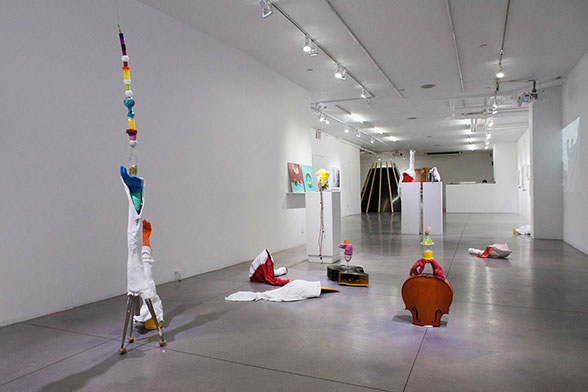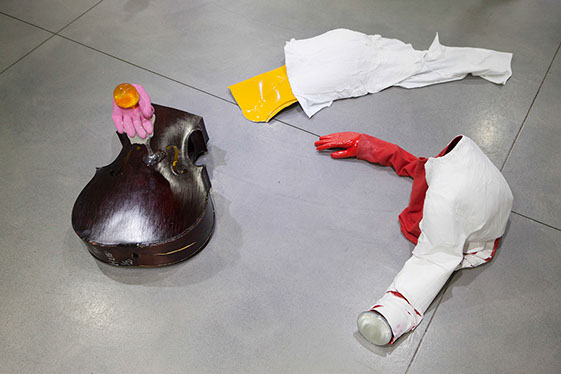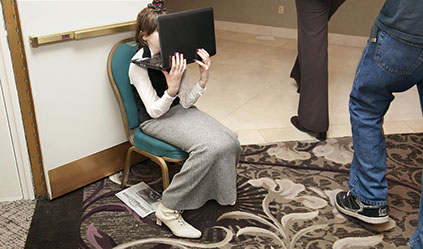

In, Side –Throughout
Installation shot
Photo: courtesy of BOSI Contemporary
For her first exhibition at BOSI Gallery, the Israeli-born, NYC based curator Naomi Lev has brought together three artists in whose work she sees an engagement with the rituals of everyday life. Featuring sculptures and videos by Aimée Burg and Tamar Ettun alongside the photographs and photo-collages Mónika Sziládi, “In, Side – Throughout” is an exploration of contemporary human/object relationships. While there is certainly something disheartening about the erosion of humanity within an increasingly object-oriented society, the show somehow manages to remain optimistic by pitting a subtly feminist, neo-primitive, utopian approach to the physical world against the drab, cynical and utilitarian processes of daily life.
In the press release, Lev writes, “The object can become humanized and fetishized and the human on the other hand, can be objectified” and these two slippages are most clearly evident in Tamar Ettun’s sculptures and Mónika Sziládi’s photographs. For most of these sculptures (all of which were made in 2014) Ettun combined plaster casts of human body parts with found and readymade objects, giving the work a humorous anthropomorphism that reaches its apogee in the piece Boobs on red shirt, in which she stretched a sheer red top over a stool and imbued it with breasts. Other works strike a rather creepy tone, such as a group of plaster gloves that reach up from the floor like zombie hands from beyond the grave, or the piece Face with saxophone cleaners and firefighters lamp: a yellow plaster face, its mouth stuffed full of dangling wires.

In, Side –Throughout
Installation shot
Photo: courtesy of BOSI Contemporary
While it may seem as if the human elements in Ettun’s sculptures are being choked or subsumed by the mass produced objects, it is also possible that those human elements might be giving birth to or vomiting the technological elements, or perhaps the objects themselves are evolving and becoming more human. In any case, we humans are definitely becoming more “objectified”, both as economic units that can be bought and sold and as sexual objects. By repurposing rubber gloves in many of her sculptures, Tamar Ettun subverts their intended use as a tool of house work, a duty which has historically been foisted upon women without remuneration or credit. The boobs on the red shirt can further be read as a tongue in cheek allusion to the physical objectification of women.
Similar concerns arise in Mónika Sziládi’s photographs, most of which are actually photo-collages that almost seamlessly combine multiple images of parties and gatherings to create imaginary tableaus. When we can see their faces, the people in her pictures seem distant and removed, oblivious to the camera and absorbed in their own worlds. Often times their faces are obscured by an object, as in Untitled (Laptop) (2011), in which a young girl sits in a chair by a doorway, using her arms to prop up a laptop right in front of her face. The carpet beneath her connotes a hotel convention hall, but if you look closely at the floral pattern you’ll notice that it changes, and that the people walking through the door are actually from a different convention at a different hotel.
Sometimes women’s bodies are foregrounded but their faces are cropped out of the frame. The striking piece Untitled (Ribs) (2009) is a crowd scene of faceless bodies—all of them shot from the neck down, or with their faces otherwise obscured—collaged from images of two different parties, who are centered around the scantily clad body of a bony woman in a fancy dress. In another arresting picture, Untitled (Mic) (2014), a woman in a skin-tone bathing suit emblazoned with a black leather cross stands in the middle of far-out modernist architectural space, awkwardly

Monika Sziladi
Untitled (Laptop), 2011
Archival Inkjet Print
Photo: courtesy of BOSI Contemporary
clutching a microphone in her hands. Other images put greater emphasis on the female body in relation to objects, as in Untitled (Pump) (2012), which depicts a woman using a breast pump in a matter of fact way that diminishes the taboo around lactation that prompted the use of breast pumps in the first place. By keeping most of her subjects’ faces out of the frame, Sziládi causes us to focus less upon their individual identities and more on the ways in which their bodies operate within space and the ways in which we lean upon objects as social crutches or prostheses.
At the back of the exhibition the artist Aimée Burg created a sculptural environment with an abstracted tipi at its center. Inside the semi-circular Tipi (2014), which is made from wood and stretched plastic, there sits a number of objects that look like they might serve ritual purposes –titles such as silver phallus fertility and breast fertility confirm this to be the case. In a small video embedded in the surface of the nearby installation Wedge (2014), Burg can be seen sitting in the woods with her toddler aged son, using some of the sculptures in an imaginary ritual of her own design. Borrowing from both Native

Aimee Burg
Home (Installation), 2014
Photo: courtesy of BOSI Contemporary
American culture and ancient fertility cults from all over the world, Burg seems to be devising her own utopian culture rooted in motherly affection, nature worship, and play.
A chirping sound resonates throughout the exhibition. Although this sound might initially be mistaken for the chirping of a bird, it is actually comes from a short video by Ettun titled FEEDBACK (2010), in which someone hangs upside down from a tree and swings a microphone around in a circle by its wire. A young girl is standing in the snow nearby, skidding back and forth as she attempts to bring another device as close as possible to the swinging mic without causing a collision, resulting in the feedback noise that gives the piece its name. The fact that the noise is not coming from a bird singing in the branches of a tree, but rather from a curious collaboration between humans, technology, and nature, encapsulates the spirit of show as a whole. While technology and the mass-produced object may continue to play an increasingly dominant role in our daily lives, there remains a glimmer of spiritual potential embedded within the “fetish” of commodity fetishism. All we need do is use our imagination and stay grounded in nature, and a whole world of liberatory possibilities might open up.

Tamar Ettun
Face with saxophone cleaners and fire fighters lamp, 2014
Photo: courtesy of BOSI Contemporary
In, Side –Throughout
September 17 - October 25, 2014
Bosi Contemporary
48 Orchard Street
New York, NY 10002
Hours
Tuesday - Saturday 11am-7pm
and by appointment
Disclaimer: All views and opinions expressed are those of the authors and do not necessarily reflect the views of the editors, owner, advertisers, other writers or anyone else associated with PAINTING IS DEAD.
